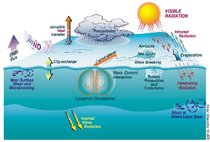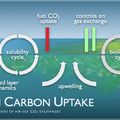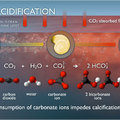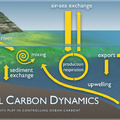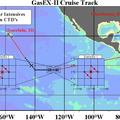Gas Exchange (GasEx) Process Studies
The GasEx studies have helped improve our understanding of air-sea gas exchange
Currently, large uncertainties in the air-sea flux of CO2 prevent verification of the partitioning of fossil fuel CO2 between the ocean and the terrestrial biosphere. These uncertainties limit the ability of models to realistically predict future atmospheric CO2 levels. Techniques are now in hand to improve estimates of air-sea fluxes. The first gas exchange experiment, GasEx-98, occurred in the CO2 sink region of an anticyclonic warm core ring in the eastern North Atlantic during May and June of 1998.Air-sea gas exchange was studied using a variety of direct and indirect approaches. For more information please visit the GasEx-98 web site.
The second study, GasEx-2001, took place in the upwelling region of the eastern Equatorial Pacific in February and March, 2001. The low annual mean wind speeds in the Equatorial Pacific and high ΔpCO2 values, offered a unique opportunity to directly determine the fluxes in a low wind stress environment and to elucidate the factors controlling the flux. Most of the GasEx-2001 experiments involved measurements taken by and around a drifting array of near-surface instruments. For more information please visit the GasEx-2001 web site.
 The latest GasEx study was conducted in the Atlantic sector of the Southern Ocean (SO-GasEx) between 29 February and 12 April, 2008. The scientific work concentrated on quantifying gas transfer velocities using deliberately injected tracers, measuring CO2 and DMS fluxes directly in the marine air boundary layer, and elucidating the physical, chemical, and biological processes controlling air-sea fluxes with measurements in the upper-ocean and marine air. The oceanic studies used a Lagrangian approach to study the evolution of chemical and biological properties over the course of the experiment using shipboard and autonomous drifting instruments. The SO-GasEx) experiment was designed to address the following questions:
The latest GasEx study was conducted in the Atlantic sector of the Southern Ocean (SO-GasEx) between 29 February and 12 April, 2008. The scientific work concentrated on quantifying gas transfer velocities using deliberately injected tracers, measuring CO2 and DMS fluxes directly in the marine air boundary layer, and elucidating the physical, chemical, and biological processes controlling air-sea fluxes with measurements in the upper-ocean and marine air. The oceanic studies used a Lagrangian approach to study the evolution of chemical and biological properties over the course of the experiment using shipboard and autonomous drifting instruments. The SO-GasEx) experiment was designed to address the following questions:
• What are the gas transfer velocities at high winds?
• What is the effect of fetch on the gas transfer?
• How do other non-direct wind effects influence gas transfer?
• How do changing pCO2 and DMS levels affect the air-sea CO2 and DMS flux, respectively in the same locale?
• Are there better predictors of gas exchange in the Southern Ocean other than wind?
• What is the near surface horizontal and vertical variability in turbulence, pCO2, and other relevant biochemical and physical parameters?
• How do biological processes influence pCO2 and gas exchange?
• Do the different disparate estimates of fluxes agree, and if not why?
• With the results from Southern Ocean GasEx, can we reconcile the current discrepancy between model based CO2 flux estimates and observation based estimates?
For more information please visit the SO-GasEx web site.

